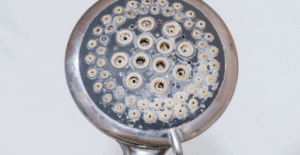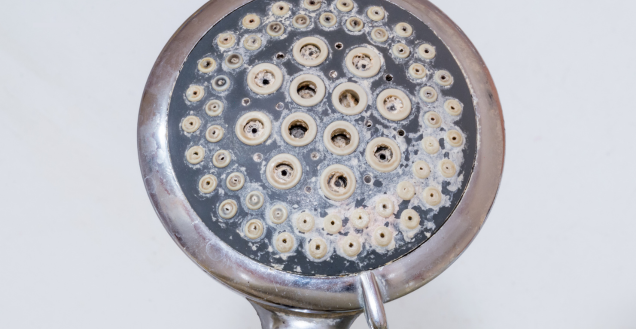If your well water tastes briny or leaves white residue on fixtures, salt may be the cause. In Connecticut and other snow-prone states, rising sodium and chloride levels in private wells are a growing concern. Common sources include road salt runoff, natural mineral deposits, and water softener discharge. This guide explains why salt enters well water, the health and plumbing risks it can cause, and how to test, treat, and prevent it.
What Causes Salt in Well Water?
Salt in well water typically comes from one of three sources: road salt runoff, natural minerals in the soil and bedrock, and discharge from water softeners. In Connecticut, where heavy winter salting is common, many wells are vulnerable. Identifying the cause is the first step toward choosing the right treatment.
Road Salt Runoff
In winter, large amounts of sodium chloride are applied to roads, driveways, and sidewalks. As ice melts, the salty runoff seeps into the ground. If your well is located downhill or close to paved surfaces, this water can carry salt into the aquifer and your drinking supply.
Naturally Salty Bedrock and Soil
Some parts of Connecticut have bedrock with high salt content, such as shale or old marine deposits. As groundwater moves through these formations, it can dissolve sodium and chloride, creating naturally salty well water even in undeveloped areas.
Water Softener Discharge
Water softeners replace calcium and magnesium with sodium, and then flush out the salt during regeneration. If this brine is discharged into a septic or leach field, salt can build up in the surrounding soil and migrate into the well over time.
Is Salty Water Safe to Drink?
Salt in well water isn’t always obvious by taste, but even small amounts can pose risks, especially for vulnerable groups. It can also damage plumbing and appliances over time.
Sodium and Health Risks
Most healthy adults can tolerate some sodium in drinking water. However, people with high blood pressure, heart disease, kidney issues, or low-sodium diets may be at risk. Health guidelines from the CDC and many state agencies recommend keeping sodium below 20 mg/L for these individuals.
Infants are especially sensitive. Mixing baby formula with high-sodium water can exceed safe daily intake and put strain on developing organs.
Chloride and Corrosion
Chloride makes water more corrosive, increasing the risk of lead, copper, and iron leaching from pipes. The EPA recommends a secondary maximum of 250 mg/L chloride to avoid taste issues and corrosion. Water above this level may taste salty, leave deposits, and damage fixtures.
Signs Your Well Water Might Be Salty
Salt contamination in well water often builds up slowly, and the signs aren’t always obvious. Unlike bacteria or strong-smelling chemicals, salt can go unnoticed for months. Still, there are several symptoms to watch for.
Common Indicators of Salt in Well Water
- Salty or metallic taste — Most noticeable in drinking or cooking water
- Dry or irritated skin and hair — High sodium can affect how soap rinses off
- White scale or residue — Salt leaves chalky deposits on faucets and glassware
- Appliance wear — Dishwashers, water heaters, and washing machines may corrode or break down faster
- Rust or pitting in plumbing — Corrosive water caused by chloride can damage pipes over time

If you notice any of these signs, especially after winter or near roads that are frequently salted, it’s a good idea to have your well water tested.
How to Test for Salt in Well Water
You can’t rely on taste alone to know if your water contains salt. Even harmful levels of sodium or chloride may not change how the water looks or tastes. The only way to know for sure is through testing.
What to Test For
When testing your well water for salt, you should request a full panel that includes:
- Sodium (Na⁺)
- Chloride (Cl⁻)
- Total Dissolved Solids (TDS)
- Electrical Conductivity
- pH and corrosion potential (optional but helpful)
These indicators help determine how much salt is present and whether your water is becoming corrosive.
How Often to Test
For most households, annual testing is recommended, especially in Connecticut and other regions where road salt is used heavily in winter. If your well is located downhill from a roadway or driveway, spring is the most important time to test, right after snow and ice melt.
Testing Options
- Certified Lab Testing
Provides the most accurate results. Expect to pay $30 to $100 for a standard salt panel. - At-Home Test Kits
Useful for basic screening, but not all detect low sodium levels. Choose kits that specify sodium, chloride, or TDS. - Conductivity Meters
Handheld meters measure conductivity, which increases with salt levels. These tools can help monitor changes over time but are not a substitute for lab tests.
How to Remove Salt from Well Water
If your well water has high salt levels, treatment is possible. The right system depends on how much water you need to treat and whether you’re targeting sodium, chloride, or both.
Reverse Osmosis (RO)
Reverse osmosis is the most effective and commonly used method for removing salt from drinking water. RO systems use a semi-permeable membrane to remove sodium, chloride, and other dissolved solids.
- Effectiveness: Removes up to 99 percent of salt
- Best for: Drinking and cooking water (point-of-use installation)
- Considerations: Produces wastewater during operation, needs regular filter and membrane replacement
Distillation
Distillation involves boiling water and collecting the condensed steam, which leaves behind salt and other impurities.
- Effectiveness: Nearly 100 percent salt removal
- Best for: Small quantities of drinking water
- Considerations: Uses significant energy, slow process, higher upfront cost for larger units
Anion Exchange Systems
While traditional water softeners exchange calcium and magnesium for sodium, anion exchange systems can remove chloride by exchanging it for other harmless ions like bicarbonate.
- Effectiveness: Can reduce chloride, but not always sodium
- Best for: Specific cases where chloride is elevated but sodium is not
- Considerations: Requires regeneration chemicals and regular maintenance
How to Prevent Salt Contamination in Your Well
The best way to avoid salt in your well water is to reduce the chance of exposure in the first place. Here are a few key prevention strategies:
- Site your well upslope from roads, driveways, or parking areas that receive heavy salting.
- Seal your well casing properly to block surface runoff from entering the borehole.
- Divert water softener discharge away from your septic system or drain field.
- Use minimal de-icing salt on your own property, and sweep up extra salt after storms.
- Encourage smart salting practices in your town, such as calibrated salt spreaders and pre-wet brine use.
Prevention is often easier and cheaper than treatment. If you’re planning a new well or already testing yearly, you’re ahead of the curve.
Final Takeaways
Salt in well water is a growing concern, especially in states like Connecticut where winter road salting is routine. Whether the source is runoff, natural minerals, or softener discharge, elevated sodium and chloride levels can affect your health, plumbing, and appliances.
Here’s what to remember:
- Test your well annually, especially after winter.
- Use reverse osmosis for reliable salt removal in drinking water.
- Prevent contamination by managing runoff and softener discharge.
If you suspect salt in your well, start with a certified water test. From there, you can decide on the best treatment and prevention steps for your home.
If you have questions about your well system or need expert assistance, Greco & Haines is here to help. With a longstanding reputation for quality service across Connecticut, we’re dedicated to keeping your water supply clean, safe, and reliable. Give us a call anytime at 203-735-9308, 203-777-2256, or toll-free from any CT area code at 1-800-922-2958.

